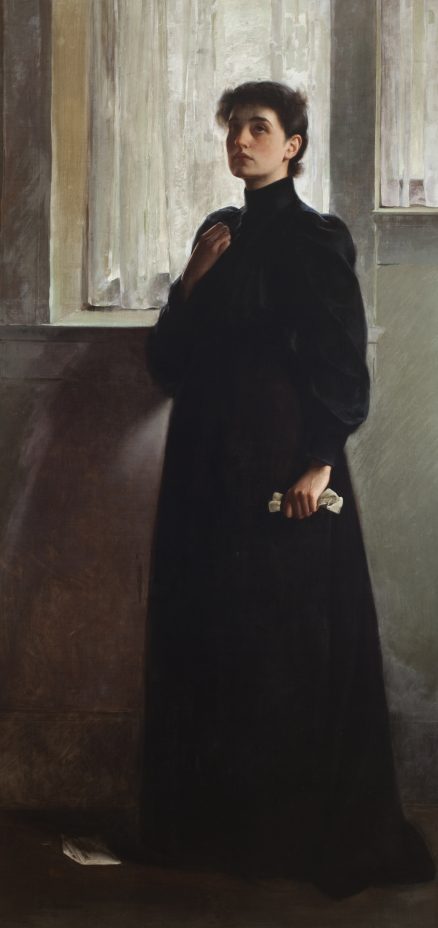- Categories
- Figural works
- Women
- Zoom in on Artwork
- Print Page
- Email Page to Friend
In Oliver Dennett Grover’s Thy Will Be Done, a young woman dressed in mourning raises one hand to her breast and gazes heavenward. Apparently, the paper she grasps brings news of a devastating loss. Starkly outlined against curtained windows bright with daylight, the life-size figure is dramatically illuminated from the right, leaving the other side of her face in shadow. In this nearly monochromatic painting, light and dark convey the woman’s conflicting emotions of grief and pious resignation. The nature of her loss, perhaps the sudden death of a lover far away, is unspecified, with the focus rather on her spontaneous reaction—a surrender to divine guidance—as a model for the empathetic viewer. The lesson is couched in contemporary terms, for the woman wears a gown of the current fashion and she has received her bad news through the modern medium of a telegram, as suggested by the printed envelope on the floor.
Grover may have intended Thy Will Be Done to secure his reputation as a serious figural painter. When he created it in 1892, he had no portrait commissions to his credit and was mainly occupied as a principal in a scenic and decorative painting partnership. Perhaps his most ambitious independent work to date, Thy Will Be Done was a stunning success. It won the first Yerkes Prize offered at the Chicago Society of Artists’ annual exhibition, in 1892, and the following year it was juried into the highly competitive U.S. section of the vast fine arts display at the World’s Columbian Exposition. The Art Institute of Chicago was rumored to be contemplating purchase of the painting at the time it won the Yerkes Prize; instead, a fairgoer bought it from the artist and it disappeared from Chicago for more than a century.
The vertical format and somber tones of Thy Will Be Done clearly echo the full-length portraits of James McNeill Whistler, suggesting Grover’s fervent admiration for the American expatriate master. In 1891, the year Grover painted this important work, the acquisition of Whistler’s famous 1871 monochromatic painting Arrangement in Grey and Black: The Artist’s Mother by the Musée du Luxembourg in Paris was widely publicized. In contrast to Whistler’s “art for art’s sake” approach, however, Thy Will Be Done affirms moral storytelling as art’s primary function. The critical success of Grover’s painting was instrumental in advancing his career, but it proved an anomaly in his easel work: he subsequently confined himself to straightforward portraits, landscapes, and the sort of undramatic modern genre scenes represented by his Breakfast on the Terrace.
Wendy Greenhouse, PhD

